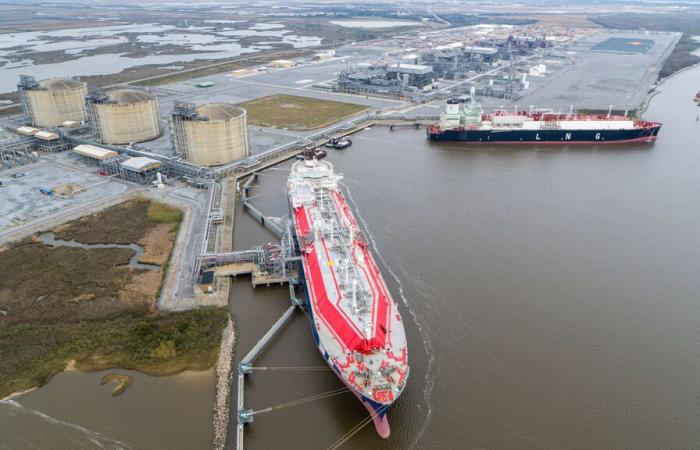From the point of view of the earth's climate, the results of the operation are less rosy. While gas is often presented as a “transitional fuel”, a recently published scientific study undermines this narrative, and figures that LNG exported by the United States would warm the atmosphere more than coal! A striking observation, as the world continues to bet big on this energy vector. Donald Trump should, upon his return to the White House, reverse the moratorium in force on the installation of new natural gas liquefaction terminals on the American coasts.
Methane leaks underestimated
The article in question, signed by Cornell University professor Robert Howarth in the journal Energy Science & Engineering and published in early October, was eagerly awaited. “The study had a huge impact, because it attacks a sort of principle that was acquired by a lot of people, according to which gas has a beneficial effect on the climate by replacing coal.», relates Anne-Sophie Corbeau, researcher at the Center on Global Energy Policy at Columbia University, in the United States, and specialist in natural gas. The notoriety of the author, who had shown the climatic limits of blue hydrogen (from fossil gas combined with carbon capture), also plays a role. To the point that the Biden administration had put forward a first version of its study to justify a moratorium on new natural gas liquefaction installations, which Donald Trump plans to reverse.
How can we explain this reassessment, when we have known for a long time that natural gas is a fossil fuel, and therefore emits CO2 when burned. According to Robert Howarth, it is not this stage which is the most harmful for the climate, but the methane leaks from the extraction of natural gas, its liquefaction and its transport. In total, the carbon footprint of heat produced with LNG over a period of 20 years (160 g of CO2 equivalent per megajoule) exceeds that of coal by 33%, and would be equivalent to that of coal over 100 years, estimates the scientist.
Natural gas has often been presented as clean because, unlike coal or diesel, its combustion emits almost no toxic particles (NOx, SOx). But from a climate perspective, “The scientific community has been warning about methane leaks for a long time, the impact of which is catastrophic», sighs Thomas Lavaux, university professor at the University of Reims-Champagne Ardenne. Satellite observations, in particular, have already shown that “oil and gas installations leak and emit a lot of methane. These emissions are underestimated in official inventories, which use emission factors measured in the laboratory that are too low.», says the researcher, who himself worked with the French start-up Kayrros on the subject.
Extraction remains the most critical phase
This is not trivial. Even if the combustion of natural gas emits less CO2 than that of coal, “methane has a very strong impact in the short term, so is crucial by 2050», summarizes Thomas Lavaux. If it reaches the atmosphere, it is around 80 times more warming than CO2 over 20 years. Against 30 times more over a century, due to its short lifespan. A fact which also leads certain oil companies to start hunting for methane, so as not to blow up their carbon budgets and respond to emerging regulations. [voir encadré].
According to Robert Howarth's study, upstream (i.e. gas extraction and transport by pipeline) remains the most critical phase. It represents 47% of the carbon footprint of American LNG! Then comes combustion, for 34% of the carbon addition. It is only then that we find liquefaction (which allows the temperature of the gas to be reduced to -162°C to increase its density), and transport by ship, which weigh respectively 9 and 6%. “Natural gas and shale gas are bad for the climate. LNG is worse», summarizes the author.
In detail, Robert Howarth estimates in particular that 2.8% of LNG produced in the United States leaks during its extraction and transport to liquefaction plants. “This is a figure consistent with studies from the scientific community», Judge Thomas Lavaux. It also highlights the detailed work of the researcher to count leaks from LNG ships, which proves to be more significant when they are equipped with modern two-stroke engines capable of reusing the gas they transport.
More room for improvement than coal
«Robert Howarth is right to point out the problem of methane emissions, and the Permian basin: a real labyrinth of pipelines, where leaks are higher than average, because gas production is associated with oil production.», judges for her part Anne-Sophie Corbeau. The comparison with coal, however, has certain limits: first, because the article is interested in the production of energy in the form of heat (and not in electrical form), and gas power plants are generally more efficient than their coal-fired counterparts. Then, because aggregating carbon dioxide and methane into “CO2 equivalent” over 20 years can lead to underestimating the long-term role of CO2. “It is better to use more complex models, which take into account the impact on the climate of emissions from a power plant over its entire lifespan.», she judges, citing the work of her colleague Robert L. Kleinberg on the subject.
For an industrialist who wishes to decarbonize, betting on a power plant or an oven that will be supplied with LNG therefore raises a question. In the short term, however, it remains difficult to do without LNG while ensuring our energy security, recalls Anne-Sophie Corbeau. Beyond that, the researcher underlines the existence of “a large divergence in the analyzes on the future of gas demand”, between those (majority) who anticipate strong future growth given current economic dynamics, and those who hope that it will quickly be dislodged by low-carbon energies.
Beware of greenwashing
In any case, “operators cannot say that the methane problem does not exist and must reduce its carbon footprint», concludes Anne-Sophie Corbeau. An observation shared by many LNG producers who, like the American EQT or the French TotalEnergies, seek to limit their production emissions. They are implementing solutions to combat methane leaks, or to electrify certain liquefaction terminals.
A strategy against which many scientists are calling for caution, worried about a risk of greenwashing. “We always want to support companies that are making efforts: it's necessary and it's going in the right direction, notes Thomas Lavaux. But electrifying liquefaction, for example, only reduces the carbon footprint of LNG by 10%. There is always the risk of investing in gas infrastructure that will operate for a long time to the detriment of low-carbon sources such as renewable energy. What is needed is a change of energy.»
European regulation puts pressure on methane
Discreetly releasing methane will soon no longer be possible! Added to the proliferation of greenhouse gas detection technologies – satellites in the lead – is the imminent arrival of the European regulation on the reduction of methane emissions in the energy sector. Published on July 15, 2024 by the European Commission, for entry into force at the beginning of August, this text establishes different levels to push hydrocarbon producers to monitor, declare, verify and reduce their methane emissions. The Delegated Act is still under discussion in Brussels (it must be adopted by mid-2027) so “the mechanisms are still quite vague, with for example a mention according to which companies must make “all reasonable efforts” to reduce their emissions, which is not defined,” comments Anne-Sophie Corbeau.
The scope taken into account, the verification methods used, or even the maximum methane intensity of the hydrocarbons which will arrive on the European market after 2030, remain notably unknown. But overall, “the European vision is to try to force exporters to reduce their methane emissions, with fines for LNG which will not be in line,” summarizes Anne-Sophie Corbeau. Enough to push the industry – which launched an oil and gas decarbonization charter at COP28 – to make efforts.






